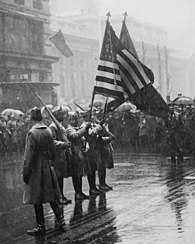Battle of Beecher Island
The battle occurred in late September 1868 with Forsyth and the scouts making a stand at Beecher Island, on the Arikaree River, then known as part of the North Fork of the Republican River, near present-day Wray, Colorado, named afterwards for Lieutenant Fredrick H. Beecher, Forsyth's executive officer killed during the battle.
In addition, they found incentive in the warfare that had been waged specifically against their clans by the military in 1867 and by memories of such atrocities as the Sand Creek massacre.
During the period 1867–1868, the Cheyenne were in schism, with those advocating peace (possibly a majority) retreating south out of Kansas and the younger, intractable warrior societies continuing to raid.
In August 1868, General Philip Sheridan replaced Hancock in command of the Department of the Missouri and was asked by acting Governor Frank Hall of Colorado for assistance after 79 settlers were killed in repeated attacks on farms, ranches, way stations, and travel routes.
As the Indians fought dispersed battles composed of small bands of warriors all over the frontier, U.S. Army troops and units were at a premium.
He ordered his aide, Major George Alexander Forsyth of the 9th Cavalry, a Civil War veteran, to raise a company of "fifty first-class hardy frontiersmen, to be used as scouts against the hostile Indians.
As the scouts were civilians, Forsyth's orders authorized him to "enter into such articles of agreement with these men as will compel obedience.
[3] Forsyth's company rode northwest nearly to Nebraska, then turned southwest and reached Fort Wallace the night of 5 September without finding any trace of Indians.
[5] Brevet Colonel Forsyth and his group of scouts departed Fort Wallace with orders to counter the raid.
[6][better source needed] The trail was heavily beaten, indicating that the opposing force considerably outnumbered the scouts, but the unit nonetheless pressed on.
They camped only 12 miles (19 km) downstream from a large encampment of two Lakota villages, one of Cheyenne Dog Soldiers (led by Roman Nose) and a few lodges of Arapaho.
[10] These were driven back and Forsyth directed his men to cross the river's shallows to a sandbar, where they tied their horses to bushes to form a barricade.
[13] During the early morning of the first day of battle, small parties of Indians dashed up to the sand bar on horseback several times, but they did little damage to the scouts.
[12] Roman Nose initially abstained from the battle, believing he would die if he fought that day because he had violated a protective taboo.
Forsyth had received three gunshot wounds: one glancing his head, another shattering his left shin, and a ball was lodged against his right femoral artery.
But Forsyth tore off the fly leaf out of his daybook, wrote a note to Col. Bankhead at Ft. Wallace, and gave it to Simpson "Jack" Stilwell.
The first was Lieutenant Colonel Louis H. Carpenter leading Troop H & I of the 10th Cavalry Regiment (Buffalo Soldiers) with Captain Baldwin.
Carpenter's Troops H & I[17] were intercepted on the plains by Scout John Donovan and four riders he had recruited after reaching Fort Wallace and starting back for the battlefield.
[20] The air around Forsyth was completely filled with a great stench and was swarming with black flies feasting on the rotting defensive line of dead horses.
He found Culver and Farley's remains, but Beecher, Wilson and Doctor Mooers' graves were empty, apparently removed by Indians.


